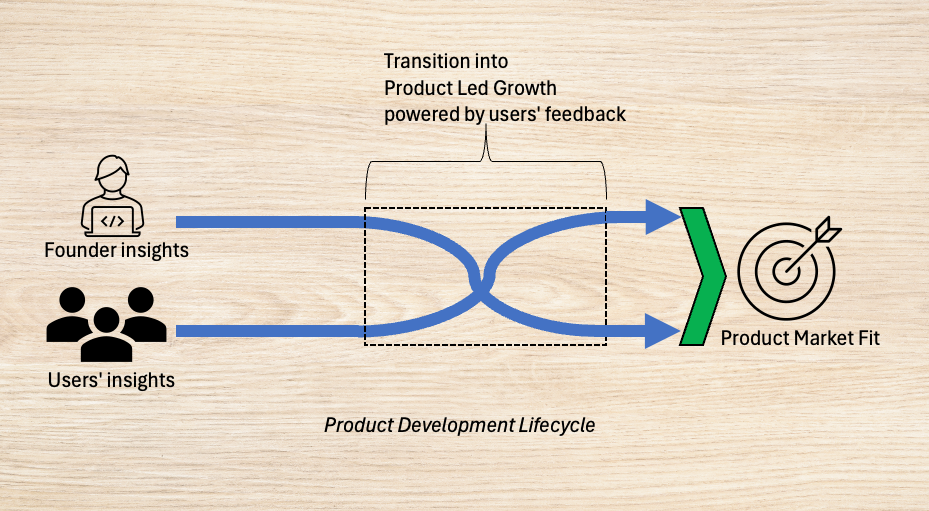What Product Organisations in Asia are Doing Well
Over the past few months, I have conducted...

At the beginning of most products lies an initial spark, an idea that hopefully addresses genuine need and solves a problem. During 0 to 1 stage, companies should prioritise focusing on the problem itself, placing it above all, including the solution. Founders believe in the power of their solution or product, diligently executing on the initial vision. In many cases they talk to potential users to clarify details and if all is well release v1. Many companies opt for a minimum viable product (MVP) initially, focusing on solving the core problem before incorporating “good to have” features. Hopefully, a dialogue with users never stops and after a few iterations and more releases, products gain better market traction.
In the B2B Enterprise products world this does not happen as often as many might think. When a product is tailored for large customers, companies often adopt a sales led growth strategy. In such organisations, decisions are often influenced by the loudest sales rep voice, or CEO/CTO come over and declare “this is the way” and instruct on the next phase of product development. Those who are familiar with such situations may recall these discussions with a wry smile or a more serious reflection.
In contrast, within product-led growth companies, an unwavering too early focus on achieving product-market fit (PMF) before problem-solution fit, can sometimes result in premature optimisation on items that are not critical for users, leading to the development of a product that is bland and lacks differentiation.
When is the right time to a shift in product direction — from being driven by the founder’s insights to being propelled by user feedback and achieving product-market fit (PMF)? In the initial stages, when founders are deeply immersed in understanding and addressing a specific problem, there’s often substantial evidence to craft a product that effectively addresses the needs of the initial group of early adopters. The founders’ profound insights and intimate familiarity with the problem enable them to devise a solution that resonates with their preferences and personal experiences. Although such products may appear distinct, they can encounter challenges gaining market traction if they fail to align well with the broader user base. This is precisely the juncture where optimisation for product-market fit should take precedence.
Ultimately, achieving product-market fit (PMF) depends on our ability to engage in meaningful conversations with users. The more we actively seek and incorporate user inputs, the better positioned we are to unearth valuable insights and develop features that resonate with our audience. Over time, this iterative process allows us to optimise our product to meet the evolving needs of a growing user base.
However, challenges arise when a company neglects to prioritise user feedback and remains stuck in executing solely on the founder’s inputs. Such companies often find themselves grappling with prolonged struggles to attain or, in some cases, never reach PMF.
One frequent issue emerges when individuals within a company believe they are sufficiently connected to their users. As a company expands, founders inevitably find their time stretched thin by various responsibilities such as hiring, sales, finances, legal, and operational demands. This dynamic can lead to a reduction in direct user interactions, resulting in what can be described as “users’ voice sampling.” As user numbers climb, it becomes increasingly impractical to engage with every individual user, reaching a point where interactions are sporadic or even non-existent. In such busy environments, there’s a risk that individuals may unconsciously seek evidence to support existing hypotheses and biases rather than genuinely seeking fresh insights. Therefore, a conscious effort to balance time constraints with the importance of ongoing user engagement becomes crucial in sustaining a dynamic and user-centric approach.
When is the optimal moment to transition from founder-led product development to a heightened focus on achieving product-market fit through user feedback? Early indicators frequently emerge within the founders themselves. This juncture is characterized by a growing awareness that certain aspects of the product are not performing as anticipated, manifesting in persistent user churn despite an increase in user numbers. Simultaneously, founders may contemplate the necessity of bringing onboard their first Product Manager.
From an external perspective, a company at this stage might have a track record of several releases, with a steadily expanding user base and a growing team. Consequently, the precise timing of this shift is distinctive for each company and often resides in the hands of the founders.
The start of the transition period is less predictable. However, it is best to move fast once a decision to transition the company into Product Led Growth powered by user’s feedback is reached, swift action is critical. Accelerating the transition expedites the journey to attaining Product Market Fit, ensuring a more rapid and effective adaptation to the users’ evolving needs.
We might say, “OK, we understand all of the above. What about the speed of achieving PMF once a decision to prioritise it is made? How do we avoid problems with biases, sampling, and inefficiencies in managing a much larger volume of data? How do we quickly synthesize and analyze that data with limited resources?”
Check out Ferilla Discovery that helps to:
We want you to succeed, to build product users need and achieve product market fit faster.
You might also be interested to read our step by step guide on thematic analysis here.
Written by